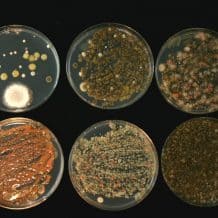Types of Molds and Harm They Cause

There are over 100,000 mold species, some more harmful than others. Mold spores are less than 4 microns in size. They are so small that as many as 250,000 spores can fit onto the head of a pin. If mold is growing in your home, in one minute your lungs can breathe in over 700,000 of these spores!
Mold Growth
Mold infestation may be obvious, or it can be hidden in places like behind walls and underneath appliances or carpet pads. Family members often become sick from exposure to mold spores before a mold problem is even suspected.
COMMON HOUSEHOLD MOLDS
Cladosporium (Hormodendrum sp.)
This is the most commonly identified outdoor fungus. It is a common allergen. Indoor Cladosporium sp. may be different than the species identified outdoors. It is commonly found on the surface of fiberglass duct liner in the interior of supply ducts. It can cause mycosis. A common cause of extrinsic asthma (immediate-type hypersensitivity: type I), acute symptoms include edema and bronchiospasms. Chronic cases may develop pulmonary emphysema.
Penicillium
Identification to species is difficult. Often found in aerosol samples, and commonly found in soil, food, cellulose, and grains, as well as paint and compost piles. It may cause hypersensitivity pneumonitis and allergic alveolitis in susceptible individuals. It is reported to be allergenic to the skin. It is commonly found in carpet, wallpaper, and in interior fiberglass duct insulation. Some species can produce mycotoxins. A common cause of extrinsic asthma. Acute symptoms include edema and bronchiospasms, chronic cases may develop pulmonary emphysema.
Aspergillus
A genus of fungi containing approximately 150 recognized species. Members of this genus have been recovered from a variety of habitats, some species are parasitic on insects, plants and animals, including man. Various Aspergillus species are a common cause of extrinsic asthma. Acute symptoms include edema and bronchiospasms, and a variety of opportunistic infections of the ears and eyes. Chronic cases may develop pulmonary emphysema, and severe pulmonary infections may also occur. Many species produce mycotoxins which may be associated with disease in humans and other animals. Toxin production is dependent on the species or a strain within a species and on the food source for the fungus. Some of these toxins have been found to be carcinogenic in animal species, and several toxins are considered potential human carcinogens.
Alternaria
Alternaria is very widespread and common. It is often found in carpets, textiles, and on horizontal surfaces in building interiors, and is common on window frames. The species Alternaria alternata is capable of producing tenuazonic acid and other toxic metabolites which may be associated with disease in humans or animals. It has been associated with hypersensitivity pneumoniti, sinusitis, deratomycosis, onychomycosis, subcutaneous phaeohyphomycosis, and invasive infection. Common cause of extrinsic asthma. Acute symptoms include edema and bronchiospasms, and chronic cases may develop pulmonary emphysema.
Mucor
Often found in soil, dead plant material, horse dung, fruits, and fruit juice; it is also found in leather, meat, dairy products, animal hair, and jute. May be allergenic. May cause mucorosis in immune compromised individuals. The sites of infection are the lung, nasal sinus, brain, eye, and skin. Infection may have multiple sites.
TOXIC MOLDS
There are two types of black mold that are normally less common but are considered very serious health hazards. Molds that are capable of generating toxins (called “toxigenic mold”) do not always produce them in every situation. Scientists believe that certain very specific conditions must be present for a toxigenic mold to actually produce toxins, such as the right combination of temperature, moisture, type of material the mold is growing on and, perhaps, competition from other microorganisms.
Stachybotrys
Stachybotrys chartarum is a fungus that has become well known as a mycotoxin producer that can cause animal and human mycotoxicosis. Evidence has accumulated showing this fungus as a serious problem in homes and buildings and one of the causes of the “sick building syndrome.”
This is one of many types of black mold that may grow on water-damaged building materials. This mold requires a lot of water or moisture to grow, and it only grows on materials with high fiber and low nitrogen content, such as wallpaper and the paper covering of wallboard (sheetrock), wood , or jute such as is frequently used for the backing of older carpets. Areas with relative humidity above 55% and are subject to temperature fluctuations are ideal for toxin production. This mold does not grow on shower tile or plastic. In the outdoor environment it is found in soil, rotting hay and leaf debris.
This mold, among others, may produce mycotoxins – chemicals that discourage growth of other microorganisms and that may also cause health problems in people. In recent years toxic molds have been front page stories in newspapers and on television shows all over the world. The fungus has led to multi-million dollar litigations and caused serious problems for schools, homeowners and building managers who have had to deal with the consequences of this problem.
Individuals with chronic exposure to the toxin produced by this fungus reported cold and flu symptoms, sore throats, diarrhea, headaches, fatigue, dermatitis, intermittent local hair loss, and generalized malaise. The toxins produced by this fungus will suppress the immune system affecting the lymphoid tissue and the bone marrow. Animals injected with the toxin from this fungus exhibited the following symptoms: necrosis and hemorrhage within the brain, thymus, spleen, intestine, lung, heart, lymph node, liver, and kidney. The mycotoxin is also reported to be a liver and kidney carcinogen. Illnesses caused by absorption of the toxin in the human lung are known as pneumomycosis.
Memnoniella
Memnoniella echinata is particularly toxic and irritating. It’s considered a member of the Stachybotrys family but unlike Stachybotrys chartarum, a sticky spore that tends to stay in its place, M. echinata is easily airborne and is often found in the air when it’s growing in the building. It’s actually more of a problem than its famous brother, Stachybotrys.
Toxic mold such as Stachybotrys and Memnoniella need water-soaked wood, paper, and cotton products to grow.
These mold types may appear slimy when wet – with white edges. When dry they are powdery, and hence can easily become airborne. The presence of black mold does not necessarily mean Stachybotrys mold is present, but some experts believe that from thirty to fifty percent of all homes and buildings may have some level of Stachybotrys infestation, even without flooding and other catastrophic problems. They are Serious problems in areas where homes have been flooded, and particularly in the warm southern states after the hurricanes and other summer storms.
Dr. Eckardt Johanning, an environmental health specialist at New York’s Mount Sinai Medical Center, has found that black mold toxins can cause mood changes, memory loss, and immune dysfunction, besides sore throats, headaches, upper and lower respiratory ailments, dermatitis, eye irritation and general tiredness. In 1999, the Kansas City Star quoted Susan Flappan saying, “I think it’s a missing link to a lot of questions we’ve had. We’ve had patients go from doctor to doctor without any explanation of what is wrong. Once they get rid of the Stachybotrys problem, their life gets better.”
Though scientists don’t understand all the effects of black mold, Sidney Efross of the EPA in San Francisco says, “There’s probably nothing we can call a safe level” of Stachybotrys.
You cannot determine the mold genera and species just by looking at it on the wall or even with a do-it-yourself mold test kit. For small mold problems, use bleach, soap and water instead. For larger problems hire an expert to survey your home, or send your own mold sample to a competent testing laboratory. The services of an experienced mycologist or aerobiologist are necessary to know what you’ve got.
If you suspect that you may be dealing with a toxic mold you should vacate the premises and have a professionals remove the mold before anyone comes back into the house. You can get quite ill yourself if you inhale a large quantity of the fungal dust or get it on your skin.
Next: Who Is Most Vulnerable to Illness from Molds






